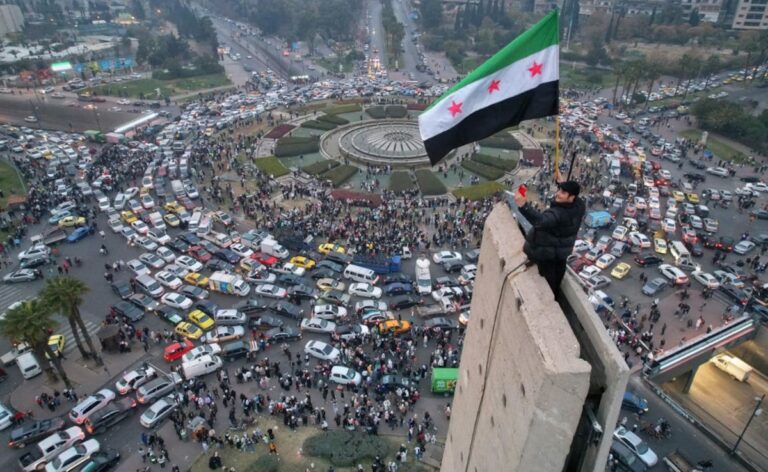
Imagine this. Syria’s current interim government, led by Hayat Tahrir al-Sham (HTS), will give way to an elected government. Under this fledgling democracy, a phoenix-like Syria is rising from the ashes of a long and bloody civil war. Millions of Syrian refugees and internally displaced persons are joyfully returning home. Investors are gradually entering the market. Broken infrastructure is being rebuilt. The signs of productivity and employment are breathing life back into an economy that was put on life support for years under the misrule of former dictator Bashar al-Assad.
Not ideal. But it is certain that the dream begins with a collective effort to rebuild Syria. This could be the best-case scenario for Syria in the near future.
Now, let’s consider the other side. The HTS-led rebels accomplish their primary mission of overthrowing the Assad regime and begin to implode. The factions within HTS suddenly begin a fierce competition to outdo each other amid chaos and infighting. Meanwhile, the Syrian National Army (SNA) (the Turkish-backed Free Syrian Army) and the Syrian Democratic Forces (SDF) (the US-backed Kurdish-led alliance) are not just holding on, they are doing everything in their power. . and seize power in Damascus. Russian military bases remain firmly entrenched along the coast, Israeli forces patrol the southern fringes, US troops are anchored in the northeastern corner, and Turkey remains a strong influence and key player. Not to be outdone, Iran is busy rebuilding its secret network of influence.
Unfortunately, this could be the worst-case scenario for Syria in the coming months and years.
chess game
As the year 2024, which was a truly seismic year for West Asia, draws to a close, Syria stands at a crossroads. It’s a precarious and painful threshold where the future is frustratingly unpredictable.
The fall of the Assad dynasty’s 54-year dictatorship has brought a glimmer of hope to millions of long-suffering Syrians. However, it also meant that they were thrown headlong into unknown waters.
If you look closely, Syria looks like a giant geopolitical chessboard, with too many players hovering over the pieces, waiting to see who will make the first move. For now, it’s all speculation and a wait-and-see game.
But amid the turmoil in Syria, the HTS, formerly known as Jabhat al-Nusra, has been forced into action by its leader, Abu al-Jolani, who now prefers to go by his real name, Ahmed al-Sharaa, who has taken on militant garb. I changed to a Western-style suit. political change. Western countries continue to take a wait-and-see attitude while still labeling HTS a terrorist group. They set conditions to protect minorities, ensure a peaceful transition of power, and possibly obtain sanctions relief. But skepticism persists.
Turkey continues its geopolitical chess game, supporting the Syrian National Army (SNA) against the Syrian Democratic Forces (SDF), which it accuses of being a front for the PKK. The Turkish government insists on disarming the PKK, which has long been a nuisance. Meanwhile, the US and UK have defended the SDF’s role in combating Islamic State terrorists. — all the while trying to allay Türkiye’s security concerns. HTS, on the other hand, plays the role of a diplomat, subtly supporting the “freedom” of the SDF region while trying to avoid playing the PKK card.
The fall of Assad would be a powerful punch to Iran’s “axis of resistance,” severing supply lines to Hezbollah in Lebanon and dismantling its carefully woven network of proxy forces. Seizing opportunities, Israel has announced its intention to expand its settlements in the Golan Heights while stepping up airstrikes against Syrian targets, with nearly 500 attacks to date. If anyone thought the situation would calm down with Assad’s departure, Israel’s actions suggest otherwise.
As for the Islamic State, rumors of its demise were premature. Americans, who once boasted that they would defeat it forever, now admit that the group is making a comeback, with attacks on Syria expected to double in 2024.
The United States, with 900 boots on the ground in Syria, remains on high alert, managing camps filled with Islamic State fighters and their families that have become hotbeds of trouble.
Meanwhile, the UN Security Council’s 2015 resolution to address Syria’s new constitution and elections remains unfinished. So in this theater of chaos, with so many writers vying to write that final chapter, scripts are still being written and will continue to do so well into 2025, so be careful.
A high-stakes drama
West Asia has long been synonymous with power struggles, ideological struggles, and resource-driven strategies. The region remains a playground for U.S. military forces, which continue to launch attacks. In 2024, a showdown between Israel and Iran narrowly avoids an all-out regional war, and brinkmanship reaches new heights.
The year also saw relentless violence between Israel and Hamas, with Hezbollah adding fuel to the fire. More than 45,000 Palestinians were killed and nearly 90% of Gaza’s population was left homeless. On November 21, the International Criminal Court (ICC) issued arrest warrants for Israeli Prime Minister Benjamin Netanyahu and former Defense Minister Yoav Gallant, charging them with war crimes during the Israel-Hamas war. This is an unprecedented action against the leader of a major Western ally. .
Many analysts believe that Prime Minister Benjamin Netanyahu’s expansionist policies and hardline stance are causing global outrage, but Arab support for Palestine remains inconsistent and rather than meaningful action. Limited to harsh rhetoric. The conflict continues to derail efforts to normalize relations between Israel and Arab countries, particularly Saudi Arabia under the Abraham Accords, which President Donald Trump began during his first term.
Fragile peace, protracted conflict
The much-lauded China-brokered rapprochement between arch-rivals Iran and Saudi Arabia in 2023 is already showing cracks. In 2024, the simmering rivalry between the two countries resurfaces, with Syria at the center of the conflict. Iran is pressuring Syria’s interim government to fulfill a reported $30 billion bilateral aid deal, but this is less about cash and more about keeping a foothold in post-Assad Syria It’s for a reason. Meanwhile, Saudi Arabia’s interests remain divided between the quagmire of Yemen and its Vision 2030 ambitions. This fragile peace risks collapsing under unresolved tensions. The proxy conflicts between Yemen and Iraq may continue to smolder or simmer, potentially rekindling destabilizing conflicts or paving the way for true regional integration.
US withdrawal and changes in regional power
Many Western analysts believe that the Biden administration’s pivot to checkmate China has pushed West Asia into a game of geopolitical musical chairs. Turkey is exerting its power as an intermediary and power broker, while the UAE is expanding its influence through shrewd economic deals and security initiatives. Despite the internal conflict, Russia maintains its strategic advantage with military bases in Syria. While a decline in the United States’ presence creates opportunities for regional powers to strengthen, it also carries the risk of increased competition. The future of West Asia is becoming more unpredictable as Türkiye, Iran, and Saudi Arabia vie for supremacy.
Beyond oil
OPEC’s production cuts in 2024 have strengthened the region’s dependence on crude oil, even as some member countries seek to diversify. Saudi Arabia’s NEOM megacity and green energy projects represent ambitions for a post-oil future. Successful diversification could stabilize the region, but failure would expose many countries to socio-economic upheaval in a world beyond oil.
power broker waiting
Turkey appears to be in a pole position to spearhead the rebuilding of Syria and play a key role in stabilizing West Asia. The embassy in Damascus has reopened for the first time in 12 years, with the Turkish government signaling its intention to play a pivotal role in Syria’s recovery from civil war and economic devastation. In the long term, Turkey’s influence is likely to increase as it moves forward with this complex reconstruction effort.
The stakes are high for Türkiye and the European Union. The promise of a stable Syria is not just about altruism. It’s a strategic necessity. European Commission President Ursula von der Leyen, who visited Ankara on December 17, announced an additional $1 billion in funding for Turkey to help refugees. This is a timely recognition of Türkiye’s hard labor. Turkey, which hosts around 3.5 million Syrian refugees, has borne the brunt of the crisis, while the EU has taken in more than 1.5 million refugees since the civil war began in 2011.
If Turkey can balance its role as a regional power and a bridge to the West, it could turn this moment into a diplomatic and humanitarian victory. This will also have a stabilizing effect on West Asian countries as a whole.
trump factor
In 2024, West Asia will be at a crossroads. While the region faces many challenges, from political instability to economic dependence on oil, there are also opportunities for change. Whether 2025 will be a year of rebirth or regression will depend on the choices of regional and global actors alike. The Trump factor will have a major impact on developments in West Asia in the new year and beyond. So far, there have been very mixed signals from the incoming Trump administration about the scope of its plans to actively engage in the region. Until that becomes clear, I don’t think any regional players will be willing to take a decisive step yet.
But as 2024 draws to a close, one thing is clear. West Asia will continue to be a region whose power relations shape the world.
(Syed Zubair Ahmed is a senior Indian journalist based in London with 30 years of experience in Western media)
Disclaimer: These are the author’s personal opinions.


